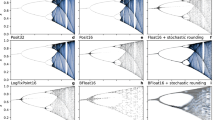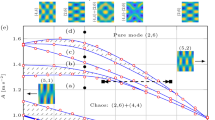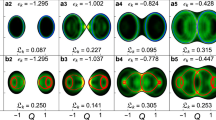Abstract
Our understanding of the Solar System has been revolutionized over the past decade by the finding that the orbits of the planets are inherently chaotic. In extreme cases, chaotic motions can change the relative positions of the planets around stars, and even eject a planet from a system. Moreover, the spin axis of a planet—Earth's spin axis regulates our seasons—may evolve chaotically, with adverse effects on the climates of otherwise biologically interesting planets. Some of the recently discovered extrasolar planetary systems contain multiple planets, and it is likely that some of these are chaotic as well.
This is a preview of subscription content, access via your institution
Access options
Subscribe to this journal
Receive 51 print issues and online access
$199.00 per year
only $3.90 per issue
Buy this article
- Purchase on Springer Link
- Instant access to full article PDF
Prices may be subject to local taxes which are calculated during checkout






Similar content being viewed by others
References
Giffen, R. A study of commensurable motion in the asteroid belt. Astron. Astrophys 23, 387–403 (1973).
Wisdom, J. The origin of the Kirkwood gaps: a mapping for asteroidal motion near the 3/1 commensurability. Astron. J. 87, 577–593 (1982).
Wisdom, J. Chaotic behavior and the origin of the 3/1 Kirkwood gap. Icarus 56, 51–74 (1983).
Wisdom, J. A perturbative treatment of motion near the 3/1 commensurability. Icarus 63, 272–289 (1985).
Wisdom, J. Meteorites may follow a chaotic route to earth. Nature 315, 731–733 (1985).
Holman, M. & Murray, N. Chaos in high-order mean motion resonances in the outer asteroid belt. Astron. J. 112, 1278–1293 (1996).
Malhotra, R., Duncan, M. J. & Levison, H. F. in Protostars and Planets IV (eds Mannings, V., Boss, A. P. & Russell, S. S.) 1231 (Univ. Arizona Press, Tucson, 2000).
Wisdom, J., Peale, S. J. & Mignard, F. The chaotic rotation of Hyperion. Icarus 58, 137–152 (1984).
Ward, W. R. & Rudy, D. J. Resonant obliquity of Mars? Icarus 94, 160–164 (1991).
Touma, J. & Wisdom, J. The chaotic obliquity of Mars. Science 259, 1294–1297 (1993).
Laskar, J. & Robutel, P. The chaotic obliquity of the planets. Nature 361, 608–612 (1993).
Ward, W. R. Comments on the long-term stability of the earth's obliquity. Icarus 50, 444–448 (1982).
Laskar, J., Joutel, F. & Robutel, P. Stabilization of the earth's obliquity by the moon. Nature 361, 615–617 (1993).
Neron de Surgy, O. & Laskar, J. On the long term evolution of the spin of the Earth. Astron. Astrophys. 318, 975–989 (1997).
Sussman, G. J. & Wisdom, J. Chaotic evolution of the solar system. Science 257, 56–62 (1992).
Murray, N. & Holman, M. The origin of chaos in the outer solar system. Science 283, 1877–1881 (1999).
Laskar, J. A numerical experiment on the chaotic behaviour of the solar system. Nature 338, 237–238 (1989).
Chirikov, B. V. Resonance processes in magnetic traps. Plasma Phys. 1, 253–260 (1960).
Hénon, M. & Heiles, C. The applicability of the third integral of motion: Some numerical experiments. Astron. J. 69, 73–79 (1964).
Kirkwood, D. Meteoric Astronomy: A Treatise on Shooting-stars, Fireballs, and Aerolites 105–111 (Lippincott, Philadelphia, 1867).
Kolmogorov, A. N. On conservation of conditionally periodic motions under small perturbations of the Hamiltonian. Dokl. Akad. Nauk 98, 527–530 (1953).
Arnold, V. I. Proof of A. N. Kolmogorov's theorem on the preservation of quasi-periodic motions under small perturbations of the Hamiltonian. Uspethi Mat. Nauk. 18, 13–40 (1963); English translation Russian Math. Surv. 18, 9–36 (1963).
Moser, J. On invariant curves of area-preserving mappings of an annulus. Nachr. Akad. Wiss. Gottingen Math. Phys. K 1, 87–120 (1962).
Froeschle, C. & Scholl, H. The stochasticity of peculiar orbits in the 2/1 Kirkwood gap. Astron. Astrophys. 93, 62–66 (1981).
Peirce, B. Development of the perturbative function of planetary motion. Astron. J. 1, 1–8 (1849).
Goldreich, P. in Cosmology and Astrophysics (eds Terzian, Y. & Bilson, E. M.) 121–129 (Cornell Univ. Press, Ithaca, 1982).
Lichtenberg, A. J. & Lieberman, M. A. Regular and Chaotic Dynamics 245–264 (Springer, New York, 1992).
Chirikov, B. V. A universal instability of many-dimensional oscillator systems. Phys. Rep. 52, 263–379 (1979).
Murray, N. & Holman, M. Diffusive chaos in the outer asteroid belt. Astron. J. 114, 1246–1259 (1997).
Wisdom, J. The resonance overlap criterion and the onset of stochastic behavior in the restricted three-body. Astron. J. 85, 1122–1133 (1980).
Wetherill, G. W. Where do the Apollo objects come from? Icarus 76, 1–18 (1988).
Morbidelli, A. & Gladman, B. Orbital and temporal distributions of meteorites originating in the asteroid belt. Meteor. Planet. Sci. 33, 999–1016 (1998).
Marti, K. & Graf. Cosmic-ray exposure history of ordinary chondrites. Annu. Rev. Earth Planet. Sci. 20, 221–243 (1992).
Vokrouhlický, D. & Farinella, P. Efficient delivery of meteorites to the Earth from a wide range of asteroid parent bodies. Nature 407, 606–608 (2000).
Darwin, G. H. On the precession of a viscous spheroid and on the remote history of the Earth. Phil. Trans. R. Soc. Lond. 170, 447–538 (1879).
Goldreich, P. Final spin states of planets and satellites. Astron. J. 71, 1–7 (1966).
Ward, W. R. Large-scale variations in the obliquity of Mars. Science 181, 260–262 (1973).
Murray, N., Holman, M. & Potter, M. On the origin of chaos in the asteroid belt. Astron. J. 116, 2583–2589 (1998).
Nesvorny, D. & Morbidelli, A. Three-body mean motion resonances and the chaotic structure of the asteroid belt. Astron. J. 116, 3029–3037 (1998).
Tisserand, F. Traité de Mecanique Celeste Tome IV (Gauthier-Villars, Paris, 1896).
Goldreich, P. & Nicholson, P. Revenge of tiny Miranda. Nature 269, 783–785 (1977).
Aksnes, K. in Planetary Rings (ed. Brahic, A.) 479–487 (Proceedings of IAU Colloq. 75, Cepadues, Toulouse, 1984).
Morbidelli, A. & Nesvorny, D. Numerous weak resonances drive asteroids toward terrestrial planet's orbits. Icarus 139, 295–308 (1999).
Laplace, P. S. Oeuvres Complete de Laplace Vol. 8, 144–145; (Imprimerie Royale, Paris, 1843–47); translation Gillispie, C. C., Fox, R. & Grattan-Guinness, I. Pierre-Simon Laplace (Princeton Univ. Press, 1997).
Sussman, G. J. & Wisdom, J. Numerical evidence that the motion of Pluto is chaotic. Science 241, 433–437 (1988).
Laskar, J. The chaotic motion of the solar system—A numerical estimate of the size of the chaotic zones. Icarus 88, 266–291 (1990).
Laskar, J. in Proc. IAU Symposium 152 (ed. Ferraz-Mello, S.) 1–16 (1990).
Butler, R. P. et al. Evidence for multiple companions to ν Andromedae. Astrophys. J. 526, 916–927 (1999).
Laughlin, G. & Adams, F. C. Stability and chaos in the ν Andromedae planetary system. Astrophys. J. 526, 881–889 (1999).
Rivera, E. J. & Lissauer, J. J. Stability analysis of the planetary system orbiting ν Andromedae. Astrophys. J. 530, 454–463 (2000).
Tennyson, J. in Nonlinear Dynamics in Beam-Beam Interactions (eds Month, M. & Herrera, J. C.) 158–193 (AIP Conf. Proc 57, AIP, New York, 1979).
Ferraz-Mello, S. & Klafke, J. C. in Predictability, Stability, and Chaos in N-body Dynamical Systems (ed. Roy, A. E.) 177–184 (Plenum, New York, 1991).
Gladman, B. J. et al. Dynamical lifetimes of objects injected into asteroid belt resonances. Science 277, 197–201 (1997).
Henrard, J. & Lemaitre, A. A perturbation method for problems with two critical arguments. Celest. Mech. 39, 213–238 (1986).
Morbidelli, A. & Moons, M. Secular resonances in mean motion commensurabilities: the 2:1 and 3:2 cases. Icarus 102, 316–332 (1993).
Ferraz-Mello, S., Michtchenko, T. A. & Roig, F. The determinant role of Jupiter's great inequality in the depletion of the Hecuba gap. Astron. J. 116, 1491–1500 (1998).
Acknowledgements
We thank P. Goldreich for helpful conversations. This research was supported by NSERC of Canada and NASA.
Author information
Authors and Affiliations
Corresponding author
Rights and permissions
About this article
Cite this article
Murray, N., Holman, M. The role of chaotic resonances in the Solar System. Nature 410, 773–779 (2001). https://doi.org/10.1038/35071000
Issue Date:
DOI: https://doi.org/10.1038/35071000
This article is cited by
-
Dynamical Systems, Celestial Mechanics, and Music: Pythagoras Revisited
The Mathematical Intelligencer (2021)
-
Bifurcations and dynamical analysis of Coriolis-stabilized spherical lagging pendula
Nonlinear Dynamics (2019)
-
Probing rare physical trajectories with Lyapunov weighted dynamics
Nature Physics (2007)
-
Is the outer Solar System chaotic?
Nature Physics (2007)
-
Astronomy: Giants in the asteroid belt
Nature (2001)
Comments
By submitting a comment you agree to abide by our Terms and Community Guidelines. If you find something abusive or that does not comply with our terms or guidelines please flag it as inappropriate.



